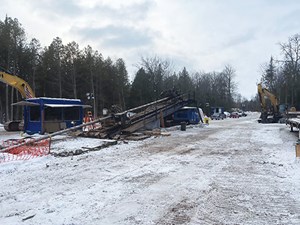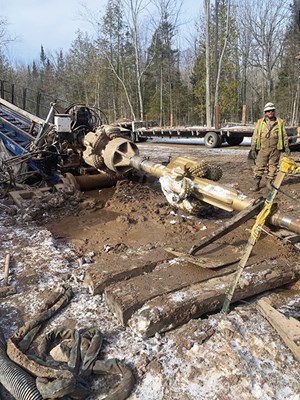June 2022 Vol. 77 No. 6
Directional Drilling
Intersect Bore Through Marshland Succeeds in Frigid Temps
By Jeff Griffin, Senior Editor
Last winter, in bitterly cold temperatures and snowy conditions, Ellingson Contracting Inc. (ECI) completed a difficult, 4,075-foot-long horizontal directional drill (HDD) intersect crossing of a swampy area in Michigan’s Upper Peninsula, to install 30-inch diameter steel pipe.
The new pipe replaces an old segment of oil pipeline that had floated atop the marshlands. The project owner, Enbridge, Minnesota Limited (MN Limited), served as the primary pipeline contractor, and ECI was the subcontractor for the HDD segment.
Due to environmental concerns in the marshland terrain, the decision was made to execute intersect pilot bores from opposite ends of the bore path. The length of the bore and the intersect of two bore holes would reduce the risk of inadvertent returns of drilling fluids from the pilot hole to the surface, said Neal Roberts, ECI project manager.
An 800,000-pound pullback Prime Drill 300 was set up on the entry side of the bore. An American Augers 440,000-pound pullback DD-440 drill was on the exit side.
MN Limited prepared work areas at entry and exit sites, including the work pads for the drill rigs and access routes to the equipment areas, which were matted to support the heavy equipment.
Support equipment for each drill rig included a mud recycling system, and Prime mud pumps, drill pipe loads, mud pump, water tanks, cuttings bins, and tooling. Other equipment was placed in a nearby staging area. The projected bore path was about 50 feet from the existing floating pipeline.
Drilling
Roberts said the Prime 300 was the main drill rig on the project. It drilled down approximately 90 feet and leveled the path of the bore. This was the average depth of the pilot hole, as well.
The Prime drill rig was equipped with an Inrock 8-inch mud motor and used a12.25-inch TCI bit. The American Augers unit used the same size and brand mud motor and bit.
The intersect point was made in front of the Prime Drill’s entry point of roughly 2,700 feet. The DD 440 pilot bore extended 1,375 feet before stopping so the Prime side bore could make the intersect.
An Inrock Gyro guidance system was used by both drill units to complete the intersect. Inrock also supplied the Cross View system for all upper echelon involved in the project to log on from a distance with a computer to monitor rig pressure, mud volumes and daily progress.
The full length of the pilot hole was completed in 28 days. Pullback reaming enlarged the pilot hole to diameters of 30 inches, then with a final pass to 42 inches. The American Augers drill unit backreamed the hole using Century Gold Series hole openers.
MN Limited laid out pipe on rollers at the exit side and the Prime unit completed the pullback in 18 hours. One mid-point weld was made. MN Limited personnel made connections at each end to the new pipeline segment.
Looking back, Roberts said the project was difficult and challenging. “The cobble and boulders made steering difficult until we reached competent rock,” he said. “Cold weather always is a challenge, and temperatures were negative 20 degrees and colder throughout the project.
Large rental heaters were used, and mud pump and mud systems were enclosed to help protect the units from the cold. When not working, mud and water lines were drained and blown out.
Roberts credited successful completion of the difficult project to a total team effort by all parties involved. “Communication from the top to the bottom is what really makes the difference,” he said. UC
FOR MORE INFORMATION:
ECI Contracting, (507) 969-9054, ecicontracting.us
MN Limited, (763) 262-7000, mnlimited.com
American Augers, (800) 324-4930, americanaugers.com
Inrock, (713) 690-5600, inrock.com
Century Products, (262) 820-3600, centuryproducts.net
Prime Direct, (715) 247-2473, prime-direct.com






Comments